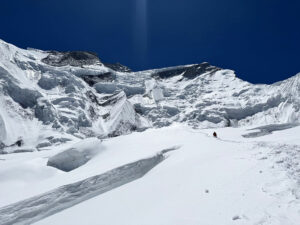The high number of fatalities and rescues was not the only problem on Everest this year. Climbers have denounced the pitiful state of the mountain’s higher camps. Camp 4, in particular, was dirtier than ever. Tenzi Sherpa, who climbed the mountain recently with Madison Mountaineering, said it was the dirtiest camp he had seen in his life.
“Lots of tents, empty oxygen bottles, steel bowls, spoons, sanitary pads, paper,” he wrote on Instagram, and included a damning video:
This is especially disappointing considering all the efforts to prevent this.
Efforts not enough
The Sagarmatha Pollution Control Committee — also in charge of fixing the route through the Khumbu Icefall every season — does all it can, but it is not enough. It manages waste issues in Base Camp, sends observers to Camp 2 to check that the garbage is handled properly, and applies the “8 kg rule.” Every climber going beyond Base Camp must bring down eight kilos of garbage on the way back.
All expeditions leave a $4,000 deposit before the climb, which they will not recover if they don’t bring down their eight kilos. Or rather, if the hired sherpas don’t bring it all back. It helps but it is far from enough.

Staff from the Sagarmatha Pollution Control Committee hold a meeting with expedition leaders in Everest Base Camp. Photo: SPCC
Cleaning campaigns are frequent on Everest, although the initiatives vary in efficiency and resources. Nepal’s Department of Tourism and the military launched the biggest recent effort in 2019 and 2021. The project took advantage of fewer people on the mountain because of COVID. They collected 10 tons of garbage and retrieved four dead bodies from Camp 4.
Also in 2019, the well-sponsored Eco Everest initiative, led by Dawa Steven Sherpa, retrieved two tons of garbage from Everest and other peaks.
Four years later, Dawa Steven says that the higher camps are again full of litter.
“My sherpas saw a bunch of tents [that] got ripped to shreds by the wind. It can be safely assumed that no efforts will be made to recover these destroyed tents and their contents,” he told ExplorersWeb recently from Base Camp, where he was coordinating his Asian Trekking team on Everest.
Other cleaning campaigns, widely promoted on social media, are more oriented toward raising awareness than doing a practical cleanup.
High camps are the worst
Also, despite some effort and the good intentions of volunteers, the sheer volume of litter left by climbers and staff is simply too much to handle. Camp 2, for instance, has grown into what is, for practical purposes, Advanced Base Camp. It features all kinds of facilities, which means more waste.
Sherpas are supposed to retrieve gear and trash from higher camps at the end of each season, but some items are more carefully retrieved than others. Lukas Furtenbach of Furtenbach Adventures says that empty oxygen cylinders are no longer left on Everest.
“Every single empty oxygen cylinder is carried down because if sherpas leave them behind, they pay us $500 for each cylinder,” Lukas Furtenbach told ExplorersWeb.
In addition to outfitting, Furtenbach owns Everest Oxygen, which supplies oxygen tanks to most teams on the mountain. “Since most of these cylinders are the property of Everest Oxygen, I know 100% that they do not stay on the mountain,” said Furtenbach. “We need them since we service and refill them every season and then rent them out again. No cylinders on the whole mountain,” he insisted.
However, the crevasses around Camp 2 have unfortunately become an easy place to drop/hide other detritus.
The problem increases with altitude. Loads high on the mountain are more troublesome to bring down. Camp 4, on the South Col at nearly 8,000m, lies on windswept and typically rocky ground. It shows the problem in all its magnitude.
Lhotse’s Camp 4, located where the routes of Everest and Lhotse split (some 250 meters below Everest’s Camp 4) is no different.
“Camp 4 of Lhotse offers an apocalyptic sight with all the remnants of last year,” said the late Suhajda Szilard, the no-O2 climber who perished on Everest a few days later. “I took four hours to pitch my tent and was proud to take all my gear with me up and down. It is outrageous that ‘oxygenated’ sherpas and their oxygenated clients leave all their stuff behind, seriously!”

Grim views of abandoned tents near Camp 4. Photo: Suhajda Szilard
Littering, cheating, and no sheriff
Careless clients may be a problem, but the responsibility ultimately lies with the companies and local authorities. A liaison officer (LO), assigned to every expedition and paid to be in Base Camp to make sure that rules are obeyed, rarely shows up. In Nepal, the job is a sinecure.
Tenzi Sherpa says that on other peaks such as K2, tents are abandoned with the company logos carefully snipped off to conceal the culprits. The reason is clear. It is much cheaper to buy new tents every season than pay porters to carry them down and then transport them down the valley or airlift them back to Kathmandu.
Experienced climbers often know who the tents belong to from the brand and fabric. But as usual, hardly anybody speaks out about controversial issues, especially if they intend to keep climbing or if they are in the mountain tourism business.
However, the sight of plastic bags and trash is undeniable for everyone who sets foot on Camp 4.
“I climbed to C4 and then to Lhotse summit with our Lhotse team, and three other guides went to Everest summit with our Everest teams,” Lukas Furtenbach told ExplorersWeb. “C3, Lhotse C4, and Everest Camp 4 have a lot of old destroyed tents from last season that were obviously left there.”






